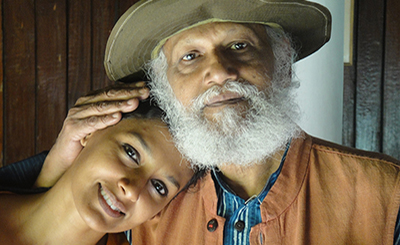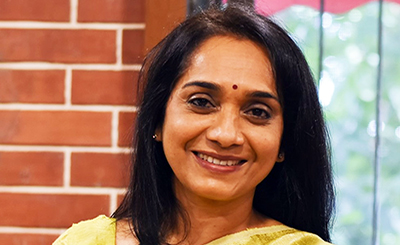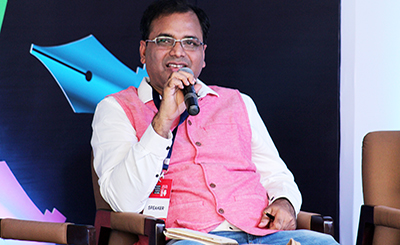
Sudeep Sen. Photo: Aria Sen
Poet’s Note: ‘The architecture of a poem is very important to me’
The architecture of a poem is very important to me — partly because of my own inherent interest in architecture itself. During my days of apprenticeship, I consciously wrote using traditional strict forms, formal metre and rhyme schemes. Of course, I have also written in free verse, but due to my penchant for formal verse you are likely to encounter a pantoum next to an acrostic poem, a triolet juxtaposed against a ghazal, lyric narratives and prose poetry, Sapphic fragments, mosaic pastiché, ekphrastic verse, sonnet, rubai, poem songs, prayer chants, documentary feeds, rap, reggae, creole, canzone, tritina, sestina, ottava rima, rime royale and variations on waka: haiku, tanka, katauta, choka, bussokusekika, sedoka.
As I became more experienced and skilled, I started innovating and experimenting, creating and inventing new forms and poetic structures. I also believe that a poem should not only be linguistically challenging, but how it appears visually is an important factor as well. For me, typography and structure of a poem are just as vital as the inner spirit and content of any poem.
If I have to locate myself geographically or culturally — then I would say I am a Bengali poet who writes in English. My relationship with Bengali is umbilical and neonatal. My parents were Bengali, and I grew up in a home speaking Bangla in a Bengali neighbourhood in New Delhi. Hindi and English were my other mother tongues. So the cultural, historical, linguistic and literary tradition of the Bengali tongue has had a very important effect of my poetic cadence, texture, rhythm and early rhyme-constructions. One very good example is my poem, ‘Durga Puja’ [re-published later in The Dhaka Tribune newspaper as part of a larger sequence, ‘Durga Sextet’]:
During the lead-up to the puja celebrations, prayers are chanedt from Chandipaath. In the poem, ‘Durga Puja’, I try to replicate its languorous baritone rhythm and its song-like cadence, as well as its long-lined couplet-structure.
In the poem ‘New York Times,’ I invented a rhyme-scheme — abxba cdxdc efxfe ... and so on ... — the middle line, i.e., the third ‘x’ line, in fact is the mirror-line which reflects the first and second lines with the fourth and fifth lines of each stanza. The other reason I used the five-line stanza-format in the poem is because the city of New York itself has five boroughs: Manhattan, Queens, Brooklyn, Bronx, etc. The other aspect about this poem is if you turn the poem 90 degrees on its central axis, then a different kind of mirrorline mimics the shape of the island of Manhattan itself and its reflection on the surrounding waters.
Another poem, a book-length sequence, Mount Vesuvius in Eight Frames (subsequently broadcast on BBC Radio as a verse-play, and premiered in London as a stage-play by Border Crossings directed by Michael Walling) is based on a series of eight etchings of a British artist, Peter Standen. The entire poem is set in rhymed couplets, reflecting the presence of two principal characters — man/woman, lover/other, life/death, and the other essential dualities. But they do not appear as obvious rhymes (like the translucent choral refrains in the poem) — they are wrap-around rhymes as opposed to endstopped rhymes. The four stanzas in each section reflect the four seasons, the four sides of a frame, the four corners of a visual space. I also use alternating line-indentation for each couplet and stanza with the idea that the entire poem works on a cyclical principle. So, if you join all the stanzas together using the left-justified margin as a reference plane, they in fact fit in a perfect dove-tail joint.
The poem ‘Single Malt’ (published in Wasafiri, UK) is one grammatical line, without any full-stops, mimicking the way whiskey, when poured gently into a crystal glass, caresses its sides and subsequently the tongue’s palette. Therefore the slim verticality of this poem’s structure:
Another example is the poem, ‘Bharatanatyam Dancer’ (published on ‘The Poetry Foundation’, USA): In this poem, it might be interesting for readers keen on form to note that the line-end rhyme-scheme — abacca ... dbdeed ... fbfggf ... — maps and mirrors the actual classical dance step pattern and beat — ta dhin ta thaye thaye ta. Also, the left hand margin indentations match the same scheme and form.
There is also my book-length poem, Distracted Geography: An Archipelago of Intent (published by Peepal Tree (UK) & Wings Press (USA): It’s one long poem over 206 pages. The sparse elongated structure of the poem partly reflects the strength and surety of the human vertebra and spine, much like Neruda’s Odes that reflects the long, thin shape of Chile. The sections and subsections join together like synapses between bone and bone. The titles are translucent markers or breath pauses, not separators. The short two-line couplets echo the two-step footprints, a pathway mapped on the atlas. The 12 sections correspond to the 12 bones in a human ribcage, the 12 months in a year, the two 12-hour cycles in a day. There are 26 bones in the human vertebrae,and the 26 parts in the poem slowly assemble themselves and form a montage of tenuously strung lyrics. The 206 pages in this book match the exact number of bones in a human body.
I am constantly innovating with form and structure. This has allowed me to invent and introduce new forms (and structure) to the English poetry tradition, ones that did not exist before. Even as the voice and technique are in a constant state of flux and growth, there is always a distinct personal signature.
*
Preparing for a Perfect Death
I want to be shattered like a dream
Such a loneliness that wants to die
—Iftikhar Arif
Get your papers in orders — choose
your inheritors fairly — with love, care.
Outline clearly — who gets what,
what they are required to execute.
Execution after your execution —
their inheritance, your legacy.
*
Thereafter, the phase of reflection —
call all who you wish to one last time,
forgive those who have wronged you,
smile, hug, and give gratitude.
Record everything in minute details —
leave no unresolved business or debts,
donate your organs, give to the needy,
veer on the side of being generous.
*
Then, the most difficult part —
how and where to die, what to wear.
Be tidy and smartly turned out—
there is no room for shabbiness here.
Of course, one would like it to be
swift and painless, without any show —
an elegant private ceremony for one,
a perfect dream end, a perfect death.
Roza
for Syeda & Gulzar
hazāroñ khvāhisheñ aisī ki
har khvāhish pe dam nikle,
bahut nikle mere armān
lekin phir bhī kam nikle
— Mirza Ghalib
I broke the fast for my 25th roza
and began the 26th with you.
— Syeda Hameed
You ate preserved sultanas
unwrapping them
from crumpled kitchen foil,
its metallic aluminium sound
echoing evening’s azaan —
its round-syllabled phrases
mirroring on stage, Gulzar’s silky
baritone-inflected Urdu.
Sultanas’ fibrous leathery
sweetness, its brown skin
peeled layer by layer
to slow-break Ramzan’s fast.
*
Poised, in the front row
on velvet red auditorium seats,
you called out my name
asking me to sit next to you.
So many years had passed
since we had last met.
Your elegant pulled-back hair,
silver and shampoo-sheened —
your crisp cotton Dhakai sari —
your warm familial smile
made even the poet on stage
acknowledge our presence.
*
This tahzeeb, this andaaz,
this intimate civilised formality,
this lack of hierarchy —
connects our faith’s purity.
Unplanned breaking of your fast,
beginning of another with me —
benediction’s invisible gift —
hazāroñ ḳhvāhisheñ aisī ….
I have a thousand yearnings,
each one afflicts me so —
many were fulfilled for sure,
not enough although.
Quiet
1.
The energy
is raw, vivid, electric.
You worship agni —
but your visage remains ice-cool,
serene.
You make me workship the fire-god —
I am in flames of energy,
yet remain
serene.
*
इसीलिए कभी कभी चुपचाप मिलना चाहिए।
मौन में you say —
that’s why one should meet in silence
in one’s mind —
we agree.
*
Fire|ice, desire|restraint,
word|wordlessness —
aren’t they made
of the same mettle?
You worship fire in public
around a temporary altar
aflame in ghee and ritual —
I do so in private, in the quiet.
*
There is nothing in the words —
they become vehicles for the energy
that we can feel from people, you say —
I remain quiet.
Will call you when there is a possibility,
you say —
I remain quiet.
2.
You invite me to yours tomorrow —
ask me quietly to hold our hands
to share our grief, our stories,
our studied practices,
our ways of seeing, living.
*
There will be time tomorrow —
to decipher, untangle
and find answers to
why so many knots remain
despite civilisational wisdom,
yoga, tapasya —
why we suppress intimacy —
why there is conflict
between
gender|genderlessness,
passion|prayer,
sadhana|kavita?
Whatever form
the poem might take —
for the moment,
I remain quiet.
3.
That tomorrow never came.
On the day, you chose instead
to plant saplings with others
and abort this bud —
its unborn petals, frayed,
quietly weeping, wilting.
I remain quiet.
*
Touch of Your Absence
[strada moldovita 9, bloc 1, scara 5, ap 45]
for Claudiu & Anastasia

Art, freedom and creativity will change society
faster than politics. — Victor Pinchuk
Mondrian must have dreamt his bio-geometries here —
squares, rectangles, bold primary colour imprint
unseasonal hues on post-Communist grey wall
masonry — suburbs’ slow coming-out, stepping
gingerly into democracy. Not unlike your country’s
recent referendum — homosexuality’s validity,
its consequence on lives of gay-couples’ children.
It is a complicated Christian mosaic of colours —
starkly different from the strident colours elsewhere.
But in its muted articulation, a passive-aggressive air
lurks — subtly choking the city’s unchecked pollution,
its underground water damage. Cerebral and psychological
hemorrhage too — pharmaceutical prescription — coded
pills, poetry’s core madness at its most beautiful, centred.
*
Max Blecher might even have been born here —
there are enough oblique clues around this apartment
suggesting an immaculate conception — ordered
disarray, phrase-fragments metrically organised.
Back-issues, stacks, volumes of Poesis; monographs,
manuscripts, unuttered syllables, unwritten poems.
My new brother here has recently lost his father —
as has Piu, my childhood friend, back home too.
Today is his chaalisvah, the fortieth-day post-demise —
you and your Anastasia are at your mother’s
helping remember his memorial — a prayer and feast,
his favourite dishes laid out for family and friends.
*
Jan Garbarek perfectly tuned threnody plays out
in inflected jazz-riffs, saxophone’s baritone
deeply haunting, heavy and melancholic —
like our hurting loves for our own fathers.
Even the stylishly new museum of contemporary art
in your city had predicted this in their masterplan —
architect’s blueprint encoding DNA’s mysteries,
an enjambment beyond emotional accidents.
George Apostu’s minimalistic bare walnut-wood
sculpture ‘Tatal si fiii’ | ‘Father and Sons’
is testimony to that — how could he, or the city-
planners predicted our un|common histories …
*
and accidental meetings of parallel lines.
Even Metro’s underground parallel tracks
defied logic of gravity, subversion and inversion.
Homeward bound from Bucharest old city centre —
as we descended the metro station’s long
series of staircases, you spontaneously and firmly
put your right hand on my shoulders, only just,
briefly. I reciprocated the same with my left arm.
Trains arrived one after another in a blur,
each jammed with people, bursting at their seams.
We boarded one, eventually — this carriage
fairly empty, but full of metronomic rail-clatter.
Unsaid brotherly vibrations echoed — a metaphor,
a concertina in couplets for an epic, yet unwritten.
*
Rain-soaked, you both arrive back even before
I could finish this impossible text — your faces flushed,
tired, your slender limbs aching with this day’s long
concentrated history of unpredictable parentages.
Simi’s transcendental healing radiates from the room
adjacent yours — the osmosis will appease the pain.
Darvánan in JG’s ‘Twelve Moons’ is still echoing:
melodic howls, crying — this Celtic song’s primal
deep notes are not sad, but a celebration —
like your hand’s subtle touch again, on my shoulders.
The essay and the poems are part of our Poetry Special Issue (January 2021), curated by Shireen Quadri and Nawaid Anjum. © The Punch Magazine. No part of this essay or the new poems exclusively featured here should be reproduced anywhere without the prior permission of The Punch Magazine.
Comments
*Comments will be moderated











